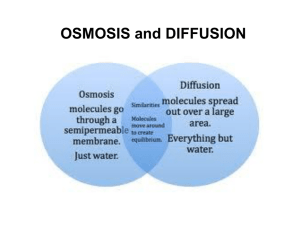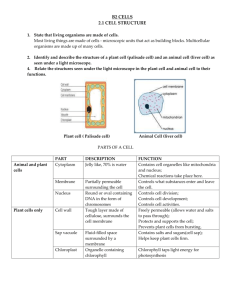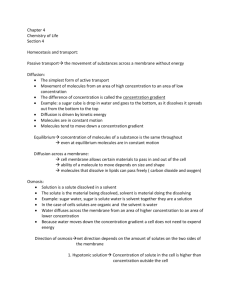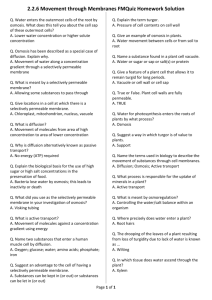Biol 160-Lab03
advertisement
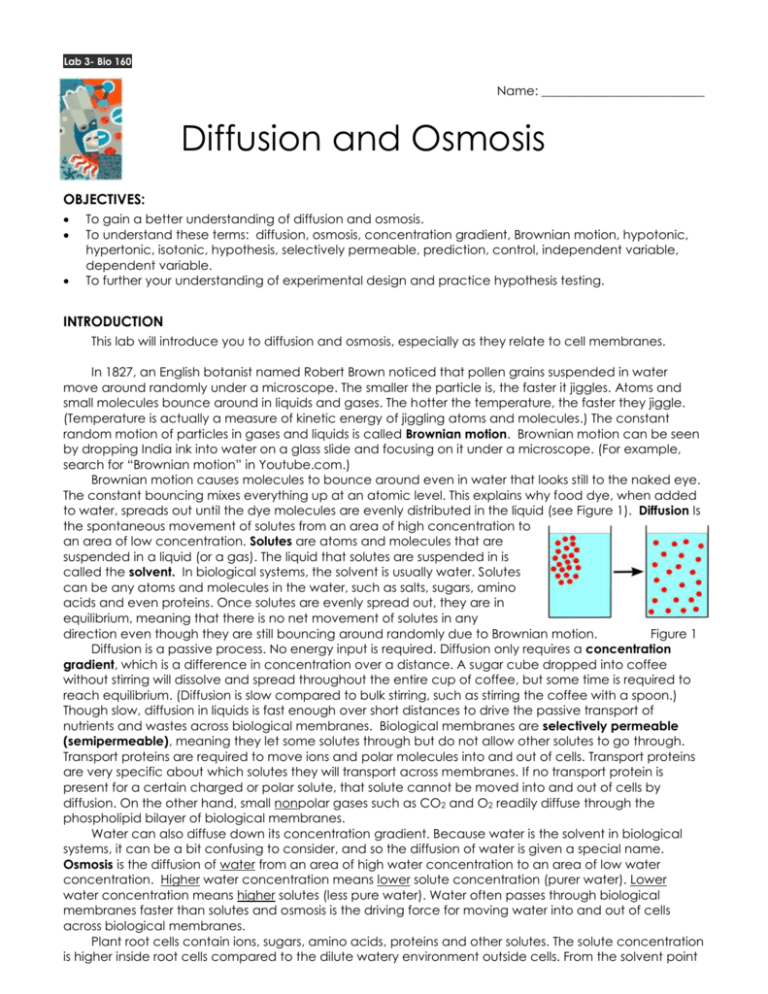
Lab 3- Bio 160 Name: __________________________ Diffusion and Osmosis OBJECTIVES: To gain a better understanding of diffusion and osmosis. To understand these terms: diffusion, osmosis, concentration gradient, Brownian motion, hypotonic, hypertonic, isotonic, hypothesis, selectively permeable, prediction, control, independent variable, dependent variable. To further your understanding of experimental design and practice hypothesis testing. INTRODUCTION This lab will introduce you to diffusion and osmosis, especially as they relate to cell membranes. In 1827, an English botanist named Robert Brown noticed that pollen grains suspended in water move around randomly under a microscope. The smaller the particle is, the faster it jiggles. Atoms and small molecules bounce around in liquids and gases. The hotter the temperature, the faster they jiggle. (Temperature is actually a measure of kinetic energy of jiggling atoms and molecules.) The constant random motion of particles in gases and liquids is called Brownian motion. Brownian motion can be seen by dropping India ink into water on a glass slide and focusing on it under a microscope. (For example, search for “Brownian motion” in Youtube.com.) Brownian motion causes molecules to bounce around even in water that looks still to the naked eye. The constant bouncing mixes everything up at an atomic level. This explains why food dye, when added to water, spreads out until the dye molecules are evenly distributed in the liquid (see Figure 1). Diffusion Is the spontaneous movement of solutes from an area of high concentration to an area of low concentration. Solutes are atoms and molecules that are suspended in a liquid (or a gas). The liquid that solutes are suspended in is called the solvent. In biological systems, the solvent is usually water. Solutes can be any atoms and molecules in the water, such as salts, sugars, amino acids and even proteins. Once solutes are evenly spread out, they are in equilibrium, meaning that there is no net movement of solutes in any direction even though they are still bouncing around randomly due to Brownian motion. Figure 1 Diffusion is a passive process. No energy input is required. Diffusion only requires a concentration gradient, which is a difference in concentration over a distance. A sugar cube dropped into coffee without stirring will dissolve and spread throughout the entire cup of coffee, but some time is required to reach equilibrium. (Diffusion is slow compared to bulk stirring, such as stirring the coffee with a spoon.) Though slow, diffusion in liquids is fast enough over short distances to drive the passive transport of nutrients and wastes across biological membranes. Biological membranes are selectively permeable (semipermeable), meaning they let some solutes through but do not allow other solutes to go through. Transport proteins are required to move ions and polar molecules into and out of cells. Transport proteins are very specific about which solutes they will transport across membranes. If no transport protein is present for a certain charged or polar solute, that solute cannot be moved into and out of cells by diffusion. On the other hand, small nonpolar gases such as CO2 and O2 readily diffuse through the phospholipid bilayer of biological membranes. Water can also diffuse down its concentration gradient. Because water is the solvent in biological systems, it can be a bit confusing to consider, and so the diffusion of water is given a special name. Osmosis is the diffusion of water from an area of high water concentration to an area of low water concentration. Higher water concentration means lower solute concentration (purer water). Lower water concentration means higher solutes (less pure water). Water often passes through biological membranes faster than solutes and osmosis is the driving force for moving water into and out of cells across biological membranes. Plant root cells contain ions, sugars, amino acids, proteins and other solutes. The solute concentration is higher inside root cells compared to the dilute watery environment outside cells. From the solvent point of view, the water concentration is higher outside compared to inside, so water tends to move into root cells by osmosis. This water intake cannot continue indefinitely because the rigid cell wall prevents cells from expanding too much. Plant cells are under pressure, like an overfilled water balloon constrained to fit into a wicker basket. This pressure is called turgor pressure, and is sufficient to hold up non-woody parts of plants. A plant that has lost its turgor pressure has wilted. Animal cells do not have a cell wall, so cells will fill up and burst in the hypotonic environment that is ideal for plant cells. A hypotonic environment is one in which the solute concentration is low outside compared to inside. Red blood cells, when placed in a hypotonic environment such as pure water, will fill up by osmosis until cells burst open like a popped balloon as there is no cell wall to slow down water uptake. The fluid surrounding red blood cells is isotonic, where the solute concentration outside is the same as the solute concentration inside. Cells neither shrink nor expand but instead, there is no net osmosis of water into and out of red blood cells. A hypertonic solution has a higher concentration of solutes outside compared to inside. You will test what happens to plant cells when bathed in a hypertonic solution. Atoms and molecules are too small to see with a microscope. We will show Brownian motion by placing a drop of hydrophobic India ink into water. (Alternatively, we may show you a clip from Youtube.com.) Simple diffusion can be seen by placing a drop of food dye into water and watching what happens. (For example, search for “food coloring diffusion” on Youtube.com.) We will demonstrate a selectively permeable membrane in several ways. First, we have a “dialysis slide”. This is simply a fancy bag made out of expensive plastic that has holes that are just big enough to allow water and ions through, but are too small to allow polymers to go through. Second, we have de-shelled eggs (shells have been removed with vinegar) that allow water to pass through but do not allow sugars to pass through. We have set-up an experimental design and you will follow it as written below. After the experiment, you can analyze the results and construct your argument about whether to support or refute your initial hypothesis (and therefore, propose an alternate hypothesis). Finally, we will look at the effects of solutions on Elodea leaves as an example of living organisms. MATERIALS (per group) FOR THE “EGG LAB” two prepared eggs scale or balance Two beakers 2 weigh boats tray for containing the eggs, etc. paper towels unknown solution A (for one egg) unknown solution B (for one egg) MATERIALS (to share) FOR THE PLASMOLYSIS LAB Elodea or Water sprite plant sprigs slides and cover slips 40% NaCl solution Squirt bottles of distilled H2O MATERIALS (for Demonstrations) microscope slide of dilute India ink dialysis slide filled with starch solution beaker of water with I2KI (Lugol's solution) added cards for illustrating the dialysis demonstration GENERAL INFORMATION 1. Work in groups (the size of the groups will be determined by the size of the class and by the amount of equipment available). PROCEDURES Brownian Motion (Demonstration) In order to understand how substances pass through a membrane, it is important to realize that molecules are in constant motion. Molecular motion is a form of energy: the translational, vibrational, and rotational kinetic energies of molecules. Although individual atoms are impossible to see here, their existence is revealed by the jiggling--called Brownian motion--of minute particles suspended in water. 1. Observe the demonstration set up on the microscope. We have placed a solution with small particles (dilute India ink) on a slide and set it up under a microscope at high power (400X). 2. Answer the questions provided on the data sheet below. Selectively Permeable Membrane (Demonstration) 1. A demonstration dialysis slide (selectively permeable membrane) and a beaker of solution with the following contents will have been set-up before class: Contents of Dialysis Slide Water Starch Contents of Beaker Water Iodine 2. This selectively permeable membrane has pores that are big enough to allow the diffusion of water and iodine but are too small to allow the transport of the macromolecular starch. Based on an understanding of the dialysis membrane and your recollection of the reaction between starch and iodine, what are your predictions regarding the movement of water molecules and solute particles when the dialysis slide is placed into the beaker? (Record on data sheet below) 3. Record the results of the demonstration experiment and construct an argument regarding your predictions on the data sheet below. Osmosis The “Egg Lab”: Determining the Relative Concentration of Two Solutions by Osmosis In this portion of the lab, you will be given two solutions. Your job is to determine which is the hypertonic solution and which is the hypotonic solution. You will be able to do this by using "model cells". We will model cells by using eggs. “Eggs??!!” you exclaim. Yes, eggs! They have been specially prepared to make the eggshell soft by soaking them in vinegar. This makes them selectively permeable to water. 1. Based on your understanding of the scientific method from the reading above and any further explanations, fill out the Hypothesis and Prediction sections of Table 2. Your hypothesis should be a general statement about osmosis; while, your prediction should be a specific statement about the expected outcome of the experiment. Often predictions are framed as “If…then…because” statements. This should be done before the experiment takes place. (Either do this before class or in lab directly before you set-up the experiment. Since this is the first hypothesis testing we have done, you can work together and/or ask the instructor for assistance.) 2. To begin the experiment (after your hypothesis and predictions have been written) carefully weigh each egg (gently drying it off beforehand). Use the weighing dish to prevent the egg from rolling off the balance. Record the data in the appropriate section of Table 2. 3. Place each egg into a beaker with solution for 30 minutes, keeping track of which egg went in which beaker! 4. After exactly 30 minutes, remove each egg, dry it off, and weigh it again as in #2. Record the data in the appropriate section of Table 2. 5. Analyze your data and construct an argument about your hypotheses and predictions based on this analysis. Plasmolysis -- Observing Osmosis in a Living System If a plant cell is immersed in a solution that has a higher solute concentration than that of the cell, water will leave/enter (circle one) the cell. The loss of water from the cell will cause the cell to lose the pressure exerted by the fluid in the plant cell’s vacuole, which is called turgor pressure. Macroscopically, you can see the effects of loss of turgor in wilted house plants or “limp” lettuce. Microscopically, increased loss of water and loss of turgor become visible as a withdrawal of the plasma membrane from the cell wall (plasmolysis) and as a decrease in the size of the vacuole (Figure 1). Figure 1. Plasmolysis in an epidermal cell of a leaf: (a) Under normal conditions, the plasma membrane is pressed against the cell walls. A large vacuole occupies the center of the cell, pushing the cytoplasm and nucleus to the periphery. (b) When the cell is placed in a solution with a higher concentration of solutes than that of the cell, water passes out of the cell, and the cell contents contract. (c) In an even more concentrated solution, the cell contents contract still further. 1. Obtain a leaf from an Elodea or Water sprite plant. Place it in a drop of water on a slide, cover it with a coverslip, and examine the material first at low power (100X) and then at high power (400X). 2. Locate a region of healthy cells and sketch a few adjacent cells in the left box of Table 3 below. Note especially the location of the chloroplasts. (Don’t forget to include total magnification.) For the next step, do NOT move the slide. 3. While touching one corner of the coverslip with a piece of Kimwipe to draw off the water, add a drop of concentrated salt solution to the opposite corner of the coverslip. Be sure that the salt solution moves under the coverslip. Wait about 5 minutes, then examine as before. 4. Sketch in the right box below the same cells you sketched in step 1. DATA SHEET – LAB 3 NAME: _________________________________ Brownian Motion Demonstration Do the particles move randomly or in a definite path? Can you see the water molecules? Are the water molecules moving? Is the movement of a particle due to the movement of its own molecules or to bombardment by water molecules? Explain. Would an increase in temperature increase or decrease the rate of Brownian movement? Explain. Selectively Permeable Membrane Demonstration: Pre-experiment Hypothesis: (instructor provided) This selectively permeable membrane will allow the free diffusion of water and iodine but inhibit the diffusion of starch. Pre-experiment Predictions: Table 1: Your Pre- and Post- observations from the Dialysis Slide Demonstration Dialysis Slide Beaker Pre-experimental contents Water, Starch Water, Iodine Pre-experimental color Post-experimental color Is there evidence of the diffusion of starch molecules? If so, in which direction did starch molecules diffuse? Is there evidence of the diffusion of iodine molecules? If so, in which direction did iodine molecules diffuse? What can you say about the permeability of the dialysis slide? (What particles could move through and what particles could not?) And what argument can you construct based on your predictions? (Using your evidence, were you correct or incorrect with your predictions?) Egg Experiment Table 2. Hypothesis: Prediction: Experimental egg A B Data Pre-soak weight Post-soak weight Data Analysis Post- minus pre-soak weight Interpretation (circle one): support reject the Hypothesis. Construct an Argument (if supported, why; if rejected, why; use evidence) If rejected, a corrected hypothesis: Reasoning (why you corrected the hypothesis the way you did): Elodea Leaf or Water sprite Plasmolysis Experiment Table 3. Sketch your Elodea leaf or water sprite cells here. Be sure to note your magnification and label your drawings! Water salt water added Elodea Leaf or Water sprite Plasmolysis Experiment continued: What happened to the Elodea or Water sprite cells placed in salt water? Assuming that the cells have not been killed, what should happen if the salt solution were to be replaced by water? Does cell turgor (rigidity) influence the overall turgor of the plant part (such as leaf or stem)? Can plant cells burst due to osmosis alone? Explain.




